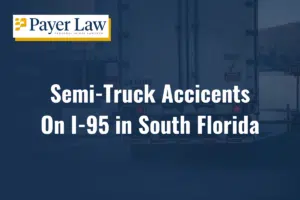Why Are There So Many Semi-Trucks on I-95 in South Florida?
I-95 isn’t just a commuter route — it’s the main artery that keeps South Florida’s economy moving. Every day, thousands of semi-trucks use this highway to move cargo between major ports, distribution centers, and retailers.
- Port Traffic: Semi-trucks flow in and out of PortMiami and Port Everglades nonstop, carrying imported cars, electronics, produce, and consumer goods.
- Distribution Hubs: Warehouses and logistics centers line the I-95 corridor from Miami-Dade to Palm Beach County. Trucks constantly enter and exit the interstate to make deliveries.
- Interstate Commerce: I-95 connects Florida’s southern ports to the rest of the East Coast — making it a nonstop trucking corridor, not just a local route.
With so many heavy vehicles merging, braking, and changing lanes, it’s no surprise that truck-related crashes happen frequently.
The Route: Where I-95 Runs Through South Florida
I-95 cuts straight through the heart of South Florida, connecting some of the region’s busiest cities and industrial zones:
- Miami: Port traffic, airport access, and dense city commuting create dangerous merging conditions for truckers and local drivers alike.
- Fort Lauderdale: Between Port Everglades and suburban commuters, truck congestion is a daily challenge.
- West Palm Beach: This stretch combines local traffic, long-haul trucks, and constant construction.
Each county has its own high-risk “truck zones,” especially near port entrances, warehouse exits, and construction bottlenecks. These areas often see the most severe collisions.
Why Do So Many Drivers Still Choose I-95?
Despite the risks, drivers — both commercial and local — stick with I-95 because it’s fast, free, and direct.
- No Tolls: Unlike the Turnpike, I-95 is free to use, making it the default route for truckers and budget-conscious commuters.
- Convenience: It connects major business hubs, industrial zones, and coastal cities — all in one continuous stretch.
- Multiple Exits: Access to downtown areas, airports, and neighborhoods keeps traffic constant and unpredictable.
But that convenience comes at a cost: constant congestion, frequent lane changes, and hundreds of heavy trucks sharing the road.
What Makes I-95 So Dangerous for Semi-Truck Accidents?
It’s not just the number of trucks — it’s the environment they’re driving in. South Florida’s I-95 has all the ingredients for serious semi-truck accidents:
- Extreme Congestion and Aggressive Driving: Tight lanes and impatient drivers make even small mistakes catastrophic. When a semi needs hundreds of feet to stop, sudden braking can trigger pileups.
- Heavy Port Traffic: Truckers are under pressure to meet delivery schedules, often driving longer hours and making quicker maneuvers.
- Ongoing Construction and Lane Shifts: Frequent projects lead to narrow lanes, uneven surfaces, and sudden merges — all dangerous for trucks.
On I-95, one wrong move — from a truck or a nearby car — can instantly turn into a multi-vehicle crash.
I got into an auto accident—an 18-wheeler hit me from the back. I went home and was in pain. It put me out of work for almost two years. After the accident, I got with Mr. Payer, and he helped me out through everything. He cares about his clients. Anytime, if a car accident or anything happens, I will refer my friends to Mr. Payer.

CLIENT

Why Semi-Truck Accidents Are So Severe
When a semi-truck crashes, the results are rarely fender-benders. Their size and weight make every collision potentially catastrophic.
- Massive Weight: Fully loaded, a truck can weigh up to 80,000 pounds — more than 20 times heavier than the average car.
- Blind Spots: Truck drivers can’t see directly behind or beside them, making lane changes dangerous for smaller vehicles.
- Load Shifts and Rollovers: Cargo that isn’t balanced can cause trucks to jackknife or roll, especially at high speeds.
- Mechanical Failures: Blowouts or brake issues can turn deadly in seconds on a fast-moving interstate.
Because of these factors, crashes involving trucks on I-95 often lead to serious injuries, multi-car pileups, and road closures that affect thousands of drivers.
How Common Are Semi-Truck Accidents on I-95?
Truck accidents happen on I-95 hundreds of times each year in South Florida alone.
- High-Risk Times: Morning and evening rush hours, heavy rain, and holiday weekends see the most crashes.
- Crash Hotspots: Miami-Dade near PortMiami, Broward around I-595, and Palm Beach County near major warehouse exits.
- Steady Trends: Despite safety efforts, the rate of truck crashes has stayed consistently high in recent years.
The takeaway? Accidents involving semi-trucks aren’t isolated events — they’re part of a continuous risk pattern on South Florida’s busiest highway.
What FDOT Is Doing to Improve Safety
The Florida Department of Transportation (FDOT) has made truck safety a priority on I-95. Some of their measures include:
- Widening lanes and redesigning exits near industrial areas.
- Installing better signage and lane markers in construction zones.
- Increasing enforcement in areas with repeat truck-related crashes.
Even with these improvements, driver awareness remains the most important safety factor. Staying alert and keeping distance from large trucks can prevent serious accidents.
Common Types of Semi-Truck Accidents on I-95
Most truck accidents on I-95 fall into a few common types — each with unique risks for other drivers:
- Rear-End Collisions: Long stopping distances and sudden slowdowns in traffic lead to frequent truck rear-ends.
- Side-Swipe Crashes: Wide turns and blind spots make it easy for a truck to clip another vehicle during lane changes.
- Jackknife or Rollover Accidents: Cargo shifts or sharp braking can send a trailer skidding sideways across lanes.
- Hazardous Cargo Incidents: When trucks carrying chemicals or fuel crash, secondary explosions and fires can occur.
These crashes can involve multiple cars and cause chain-reaction pileups that shut down large sections of the highway.
What to Do After a Semi-Truck Accident on I-95
If you’re ever involved in a truck accident, what you do next can protect your safety and your legal rights.
- Call 911 Immediately — get emergency help and report all injuries.
- Document Everything — take photos of vehicles, skid marks, and road conditions.
- Get Witness Info — contact details can be crucial for proving fault.
- Don’t Talk to Insurance Adjusters Yet — trucking companies have teams trained to limit their liability.
- Call an Experienced Truck Accident Lawyer at Payer Law — legal guidance can make or break your case.
Contact James D. Payer an Experience South Florida Injury Lawyer

Common Injuries in Semi-Truck Accidents
Because of the size and force involved, semi-truck crashes often lead to severe, long-term injuries, such as:
- Traumatic brain injuries and concussions
- Broken bones and spinal damage
- Internal organ injuries
- Whiplash and soft tissue damage
Even when injuries don’t appear immediately, internal trauma can worsen over time — making prompt medical attention essential.
Who Can Be Held Responsible After a Semi-Truck Crash?
Truck accident cases are rarely simple. Multiple parties may share responsibility, including:
- The Truck Driver: Fatigue, speeding, or distracted driving.
- The Trucking Company: Negligent hiring, training, or overloading.
- Cargo Loaders: Improperly balanced or unsecured loads.
- Vehicle Manufacturers: Defective brakes, tires, or mechanical parts.
An experienced attorney can identify every liable party and pursue the full compensation you’re entitled to — including medical costs, lost wages, and pain and suffering.
Injured in a Semi-Truck Accident on I-95? Call Payer Law.
If you or a loved one has been injured in a semi-truck accident on I-95, you’re not alone — and you don’t have to face the trucking company alone, either.
At Payer Law, our Miami-based legal team has decades of experience handling complex truck accident claims in Miami. We understand how these cases work, how insurers defend them, and what it takes to win fair compensation.
Call Payer Law today to schedule a free consultation. Your recovery — and your future — matter too much to wait.




